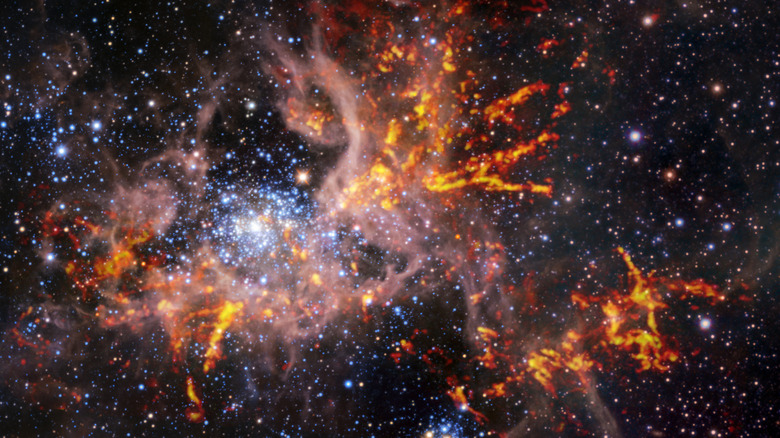How Astronomers Are Investigating This Nebula Where Stars Are Being Born
It might have a spooky-sounding name, but the nearby Tarantula Nebula is a thing of exquisite beauty. This cloud of dust and gas is located in the Large Magellanic Cloud — a satellite galaxy of our Milky Way — and is famous for being one of the first targets imaged by the now-retired Spitzer Space Telescope when it launched in 2003 (via NASA).
Now, astronomers are once again studying the Tarantula Nebula, also known as 30 Doradus, to understand how stars form there. Observations using the Atacama Large Millimeter/submillimeter Array (ALMA) in Chile are showing the nebula in new detail, by combining both infrared and radio data into one image (via ESO).
"What makes 30 Doradus unique is that it is close enough for us to study in detail how stars are forming, and yet its properties are similar to those found in very distant galaxies, when the Universe was young," explained one of the researchers, Guido De Marchi, of the European Space Agency. "Thanks to 30 Doradus, we can study how stars used to form 10 billion years ago when most stars were born."
Around 170,000 light-years away, the nebula is a bustling region and plays host to the largest-known stars in our galaxy. Some are up to 150 times the mass of our sun. It is also one of the busiest regions for star formation, making it an ideal place to study how they are born.
Stars forming from dust and gas
Stars are born when clouds of dust and gas form into clumps, and these clumps attract more material because of their gravity. Eventually, when enough material has fused together, the knot collapses under its own gravity and gets hot, becoming a protostar. This becomes the core of a star, which evolves from it (via NASA).
That's why nebulae, which are clouds of dust and gas, are often hotbeds of star formation. But it's not only the case that nebulae create stars – the stars which are born can affect the structure of a nebula in turn as well.
In the case of the Tarantula Nebula, the researchers mapped the cold gas of the nebula to see how it was affected by star formation. According to ESO, the images, which combine the ALMA radio data overlaid over previous infrared observations from the European Southern Observatory's Very Large Telescope and ESO's Visible and Infrared Survey Telescope for Astronomy, show wisps of gas which are likely the remnants of star formation.
"These fragments may be the remains of once-larger clouds that have been shredded by the enormous energy being released by young and massive stars, a process dubbed feedback," explained one of the researchers, Tony Wong of the University of Illinois at Urbana-Champaign.
But even when these clouds are ripped apart by this feedback, there can still be enough gravitational force for them to form new stars, Wong said: "Our results imply that even in the presence of very strong feedback, gravity can exert a strong influence and lead to a continuation of star formation."
The spidery shape of the Tarantula Nebula's gas clouds show cold, dense gas that has the potential to collapse and form new stars, according to the data collected by ALMA (via ESO).
